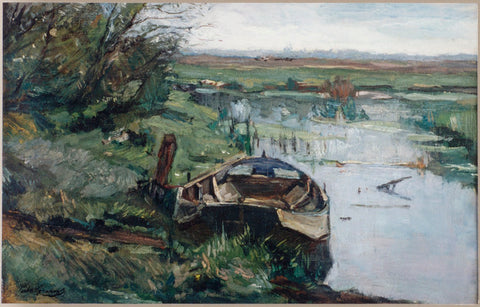Piet van Wijngaerdt (Amsterdam 1873 – Abcoude 1964) was a Dutch graphic artist, painter, draftsman, etcher, lithographer and, above all, a theorist of expressionism in the Netherlands given his influence on the Bergen School and art in the Netherlands. From 1892 to 1897 he trained at the traditional Rijksakademie voor Beeldende Kunsten in Amsterdam, after which he spent a short time in Paris, the center of the arts in those years.
In the beginning, his own work (also) had an impressionistic character in the style of the Hague School, which changed into a luminist style in 1911. From 1914 onwards he changed course again and acquired his own cubist expressionist style with large unexpected color contrasts and few details. He was then no longer concerned with the thing but with what the thing did to you in relation to other objects.
He made works of art such as: flower still lifes (of amaryllis, lily, spider chrysanthemum and gladiolus), dune landscapes, figure representations and farm scenes, portraits, interiors, landscapes, nude figures, cityscapes and self-portraits. While Van Wijngaerdt had initially painted nature with an open mind, over a period of time he developed an increasing eye for detail and his work changed visibly: light and detail became important.
When the French cubist Henri Le Fauconnier settled in a studio on the Overtoom in Amsterdam, close to Van Wijngaerdt's, he had a strong influence on the work of the luminist at that time. This can be seen in a simplification of the representation, accentuated shapes, strong contrasts and expressive color compositions that provide strong lighting effects. Van Wijngaerdt thus became one of the most important founders of Expressionism.
Together they founded the Hollandse Kunstenaarskring (HKK), of which Piet van Wijngaerdt became the chairman. Members include: Leo Gestel, Piet van der Hem, Ferdinand Hart Nibbrig and H.J. Wolters. Charley Toorop, Else Berg, Karel Colnot, Piet Mondriaan and Gustave De Smet also join later.
From 1922 to 1924 he lived in Haarlem. Back in Amsterdam he had the most success with exhibitions in the Stedelijk Museum Amsterdam in 1924 and 1935 and at the Mak van Waay art hall on the Rokin in Amsterdam and in the Lakenhal in Leiden.
In 1940 Piet van Wijngaerdt moved from Amsterdam to Abcoude. He kept his studio on the Overtoom and routinely traveled back and forth to Amsterdam by train every day. He lived in Kortenhoef at the beginning of the century, and later spent a lot of time there and met many artist friends there, such as Arnout Colnot and Dirk Filarski. That rural environment continued to inspire him throughout his life and was therefore a popular subject. He continued to work until the end of his life. He died at the age of ninety in his house on the Gein in Abcoude. In 1954, an exhibition was held again in the Stedelijk Museum in Amsterdam on the occasion of his 80th birthday. Van Wijngaerdt's work is included in the collections of the Stedelijk, the Dordrechts Museum and the Frans Hals, among others. The Boendermaker Collection contained 97 of his works.





